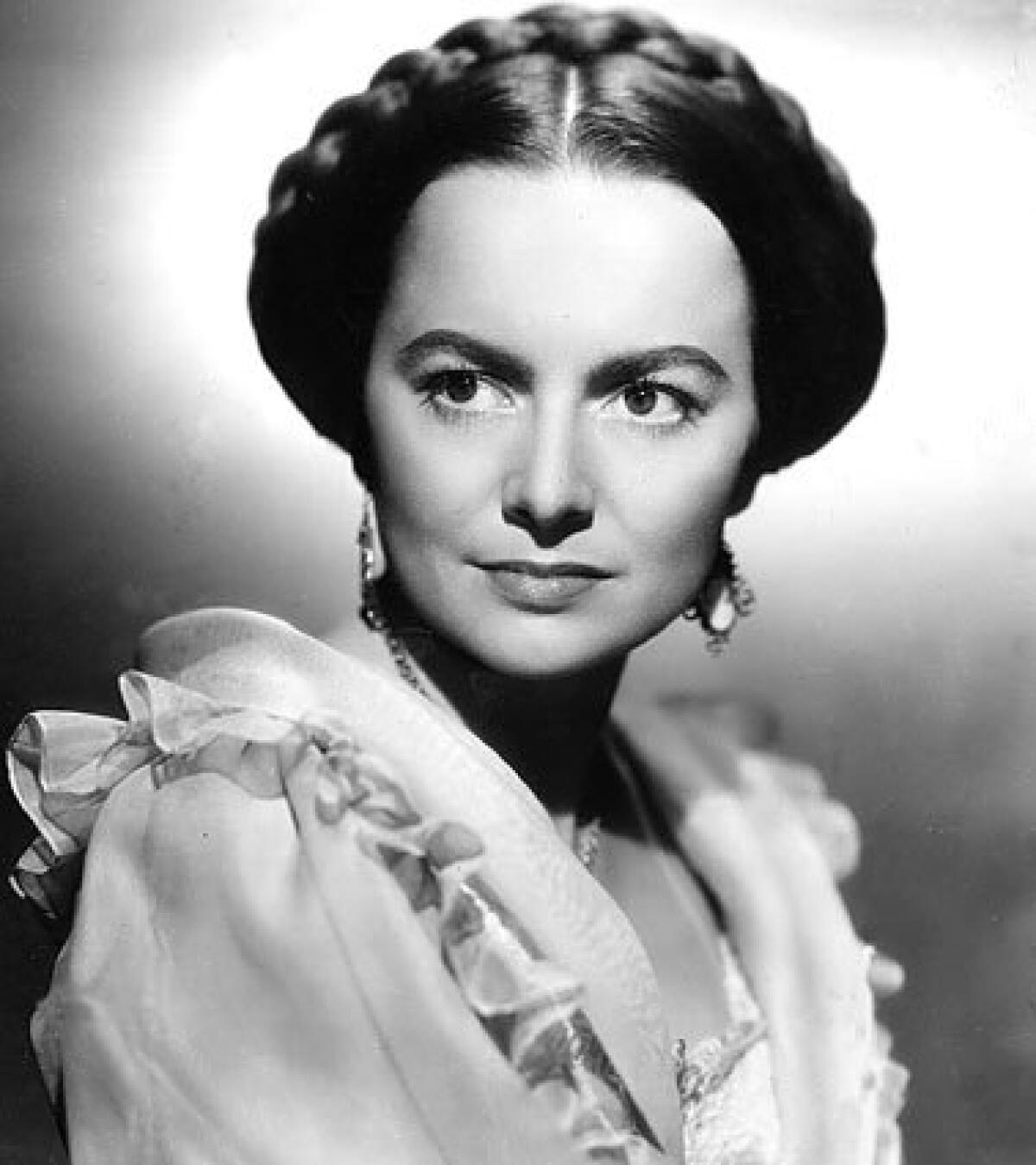Appreciation: Olivia de Havilland was never to be underestimated, in life or art

- Share via
There’s a stunning moment in William Wyler’s 1949 film “The Heiress,” in which Catherine Sloper — one of Olivia de Havilland’s greatest characters — sits quietly stitching a tapestry, much as we have seen her doing throughout the movie. Embroidery has long been one of the few simple, solitary pleasures of her cosseted 19th-century New York upbringing; in the contemptuous estimation of her father, it’s the only work she will ever be good for. It is also, of course, a classic emblem of women’s work, of the meek spinsterhood to which Catherine seems to have largely resigned herself.
But something has permanently shifted in the life, heart and mind of this once earnest and unassuming young woman, a product of her environment who becomes, in that moment, a fierce rebuke of it. We see it in the newly hardened set of De Havilland’s soft, elegant features, the angry rigidity of her posture and the downward tilt of a gaze that until now has eagerly sought the approval of everyone around her, including the camera. We hear it too in a voice that is recognizably the same one Catherine has used all along, though it now seems to have deepened several registers and turned cold with disillusionment. “Yes, I can be cruel,” she declares, with beautifully contained fury. “I have been taught by masters.”
It is hard to listen to that line and not hear an echo of De Havilland’s own film career; at the very least, you sense she knew very much of what she spoke. The story told in “The Heiress” — brilliantly adapted from a stage play that was itself inspired by the Henry James novel “Washington Square” — is that of a woman whose compassion and lack of confidence make her uniquely vulnerable to the two men in her life: a father who scars her and a suitor who both shatters and liberates her. Put another way, it’s the story of a woman coming slowly but thrillingly into her own, and whom others learn to underestimate at their peril.
And so it was with De Havilland, whose death Sunday at age 104 has severed one of our last remaining ties to the classic studio system and the film industry’s much-vaunted Golden Age. De Havilland had lived in Paris for decades and had not appeared in a picture since the 1988 British television film “The Woman He Loved.” But she was never shy about returning to the spotlight when she felt compelled to do so. In 2016, she gave a rare interview about her late sister, Joan Fontaine, and the juicy rumors of a bitter rivalry that had swirled around them since at least 1942, when they both found themselves up for the lead actress Oscar. (De Havilland was nominated that year for “Hold Back the Dawn”; it was Fontaine who won, for Alfred Hitchcock’s “Suspicion.”)
Speaking of the Oscars — two of which De Havilland would go on to win herself — I still remember the unusual warmth and intensity of the ovation that greeted her when she appeared as a presenter at the Academy Awards in 2003. Looking resplendent in blue, the 86-year-old De Havilland stood there for a moment before speaking in that wondrously deep voice, basking in the obvious affection of the crowd as well as the inevitable surge of music from “Gone With the Wind,” the film that had cemented her as a Hollywood legend.
Funnily enough in retrospect, one of that night’s big Oscar winners was Catherine Zeta-Jones, who would go on to play De Havilland in “Feud: Bette and Joan.” That FX miniseries, focused on the notorious animus between Joan Crawford and Bette Davis, became its own object of notoriety when De Havilland sued the network and Ryan Murphy Productions over the alleged misuse of her identity. She filed the lawsuit in June 2017, mere weeks after having been made a Dame Commander of the British Empire, and just a day shy of her 101st birthday, in an implicit jab at an industry known for its ageism as well as its sexism.
The lawsuit ultimately came to naught. But if De Havilland’s actions took some by surprise, it shouldn’t have. Whatever you think of the merits of her position — or the even more dubious merits of “Feud: Bette and Joan” — it was hardly the first time she had struck an important blow at a system with a long and lucrative history of treating actors like property in general, and of stifling, exploiting and underestimating women in particular. Crucially, she had proved more successful in her litigation against Warner Bros. seven decades earlier, when she sued the studio to release her from her contract. It was a groundbreaking assertion of professional autonomy from an actor who had learned to armor herself against the reflexive disdain of directors, costars and studio executives, and to fight hard for the rich, meaty roles she knew she was born to play.
She had first signed that contract when she played Hermia in Max Reinhardt’s 1935 film of “A Midsummer Night’s Dream” — a luminous debut landed on the strength of her performance in a community theater production at age 18. (Hermia might be another quintessential De Havilland role: a woman whose contented, amiable veneer cracks as fortune unexpectedly turns on her.) Her films at Warner Bros. brought her great visibility and success, mainly through her lengthy screen partnership with Errol Flynn, which began with the merry Michael Curtiz swashbuckler “Captain Blood” (1935) and ended in elegiac fashion with Raoul Walsh’s 1941 western “They Died With Their Boots On.”
De Havilland’s splendid performance as Maid Marian in “The Adventures of Robin Hood” (1938), directed by Curtiz and William Keighley, remains some of her best-loved work. But she knew she was destined for greater opportunities than the romantic interests, comic foils and second bananas that Warner Bros. threw her way. One of those post-WB opportunities led to the 1946 melodrama “To Each His Own,” which earned De Havilland her first Oscar for lead actress. (The second came three years later, for “The Heiress.”) She followed that later with her anguished star turn in 1948’s “The Snake Pit,” a pioneering achievement in Hollywood’s subgenre of prison pictures about the specific horrors of mental institutions.
Those opportunities would wane in the 1950s and ’60s, though De Havilland still did memorable work in warmly acclaimed dramas like “Light in the Piazza” (1962) as well as violent, headline-grabbing thrillers like “Lady in a Cage” (1964) and “Hush … Hush, Sweet Charlotte” (1964). The latter film gave her the chance to star opposite her longtime friend Davis, stepping into a role that had originally been intended for Crawford (in an attempt to capitalize on the success of an earlier Davis-Crawford horror vehicle, “What Ever Happened to Baby Jane”).
I’ve said deliberately little so far about “Gone With the Wind,” a movie whose recent streaming-era controversy has already generated no shortage of ink this year and a title that dominates the headlines announcing De Havilland’s death. To see the film is to understand why. In that defiantly contested, defiantly beloved 1939 landmark, she took on the role of the saintly Melanie Wilkes — a role so clearly destined for her that she managed to do it for David O. Selznick while still under contract at Warner Bros. — and made her that picture’s soulful conscience.
Defying the truism that you can’t make a virtuous character interesting, De Havilland’s Melanie serves as both a welcome corrective to the selfish Scarlett O’Hara and, remarkably, Scarlett’s most sincere and persuasive defender. Her tenderness becomes the prism through which we come to love and accept Scarlett for ourselves. And yet, no less than her contemporary Catherine Sloper, struggling north of the Mason-Dixon line, Melanie turns out to be no pushover. Beneath that warmly forgiving smile and that soothing embrace of a voice, De Havilland imparted to this woman and so many others a spine of steel and offered a subliminal reminder that she was never to be underestimated, in life or in art.
More to Read
Only good movies
Get the Indie Focus newsletter, Mark Olsen's weekly guide to the world of cinema.
You may occasionally receive promotional content from the Los Angeles Times.











